Sharpened Tech Claws More Than Scratch The Surface
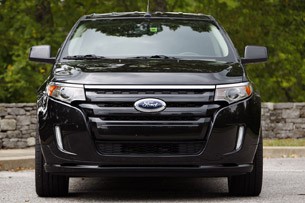
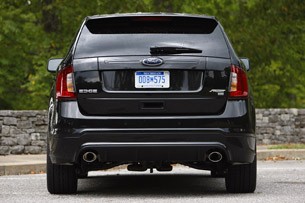
Our tester came rolling on those fancy, split five-spoke wheels and carried all of the rest of the Sport regalia as well. In its most aggressive trim, the Edge's massive chrome grille of the SE, SEL and Limited models gets swapped for a blacked-out piece that looks menacing no matter the finish. When the Edge wears the Tuxedo Black Metallic hue of our tester, the crossover is downright sinister. That effect is bolstered by the smoked tail lamp lenses and the wheel's matching wheels tuxedo-black accents. We get the feeling that this is the vehicle the FBI would use as standard equipment if it suddenly found a sense of style.
Otherwise, the Edge keeps the same not-quite-round profile we've come to appreciate outside. The story is completely different once you open the driver's door, though. Whereas the 2010 model could boast an interior that was perfectly capable of keeping its head level with the crossover waters, the 2011 version is now the same kind of beautiful found in the 2011 Mustang. The bland, blocky center stack that dominated the old dash has been banished for a new, sweeping design that features a pass-through nestled behind thin audio and climate controls. In Sport trim, those controls were designed by the minds at Sony – the same crew that penned the slick buttons on consumer electronics like the PlayStation3 and any number of massive televisions. Ford calls the control tech "touch capacitive" and there are no buttons to push or levers to slide. Simply run your finger across your choice and the electronics do the rest. It's beyond cool. While lower-rung trims don't carry the fancy Sony switchgear, they do benefit from the same touch capacitive tech. Of course, we prefer the backlit goodness of the Sport's interior, but the center stack on the SEL is just as handsome.
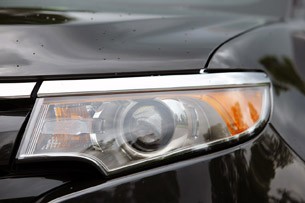
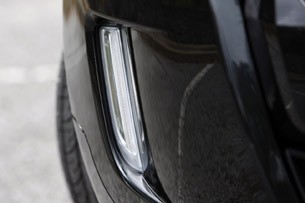
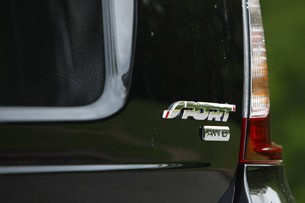
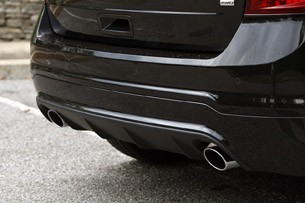
One of the biggest shortcomings of the interior in the 2010 Edge was the crossover's instrument cluster. While the rest of the vehicle carried itself as a futuristic, forward-looking craft, the gauges looked as though they'd been borrowed from the last century. Fortunately, when 1998 called looking for its speedometer, Ford was happy to hand it over. The company swapped in a slick unit with two small LCD screens on either side of a large, zero-down speedometer. Each screen is individually controlled by two five-way switches on the steering wheel. To the left, the driver is supplied with a range of pertinent vehicle information – average fuel economy from the past 30 minutes, over all fuel economy, traction control settings, temperature gauge and tachometer, among others – from easy-to-navigate nested menus. Very handy.
The right screen serves up a condensed version of the same information displayed on the large eight-inch touch screen on the center stack. In a stroke of genius, the screens are color coded – red for the entertainment system, green for navigation, blue for climate control and yellow for the hands-free phone system. The idea here is the less time the driver spends staring down and away from the road, the better. The screen will even show you your turn-by-turn directions, complete with distances and road names.
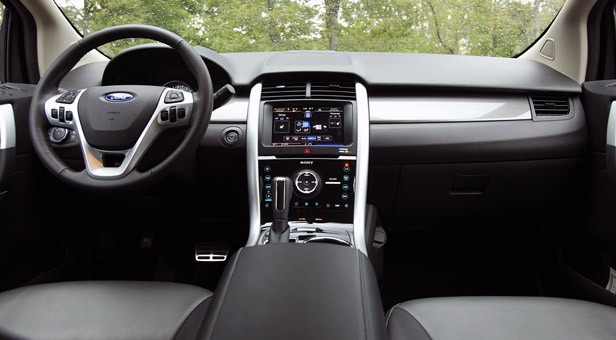
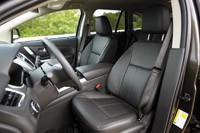
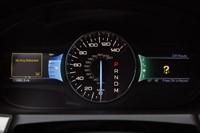
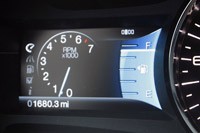
Ford also decided to debut the company's new MyTouch system on the 2011 Edge. The next evolutionary step in Sync, MyTouch now recognizes over 10,000 different voice commands, allowing you to control nearly everything in the cabin without your hands leaving the steering wheel. At least, that's the theory. During our short time with the system, we had a few issues getting the onboard brain to comprehend our (apparently) muddled voices. It did handle dialing a phone number with nothing more than a spoken command to guide it, which is pretty impressive. When it comes to adjusting the stereo or climate controls, however, we'll probably just stick to fiddling with the trick center stack controls.
More impressive is Ford's move to eschew the traditional DVD or hard drive-based navigation system in favor of a simple SD card set up. For under $800, you can have a complete map-based navigation system with 3D images of important landmarks and a bevy of points of interest. Of course, if you don't feel like shelling out that kind of cash, each Edge comes with Sync Services turn-by-turn navigation without the maps free for the first three years.
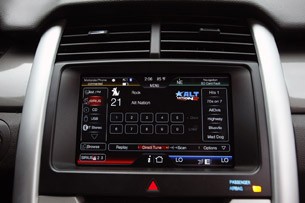
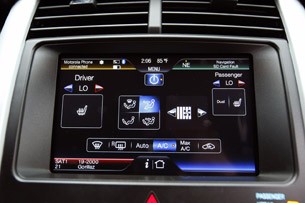
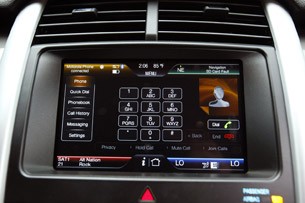
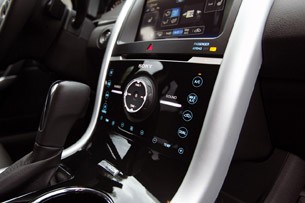
It's tempting to think that Ford simply slapped a new grille on the Edge and shoved a boatload of new tech into the cabin, but the company's engineers have taken the time to iron out some of the issues that reared their heads on the outgoing model. For starters, the cabin is significantly quieter, thanks in part to increased baffles mounted in areas previously empty, as well as a thicker firewall to isolate the cabin from engine noise. Under the hood, that sizable piece of plastic obscuring the engine helps to direct noise away from the occupants. Likewise, an acoustic windshield is part of the recipe for all models, and higher trims also get acoustic side glass to keep road noise at bay.
As anyone who has ever driven a 2010 Edge can tell you, the crossover didn't exactly come from the factory with confidence-inspiring brakes. Ford has taken care of that problem by building in a firmer pedal feel with less fade thanks to a new set of larger rear rotors as well as new calipers and pads. With the roads wet during the majority of our drive, we didn't get a chance to really lay on the stoppers, but the pedal was finally devoid of that warm marshmallow feel of last year's model.
With stopping sorted out, Ford turned its attention to working on the suspension to accommodate the larger wheel selections. Completely new springs, shock absorbers and stabilizer bars were installed to cope with the added unsprung weight, and surprisingly enough, the 2011 Edge serves up a ride that isn't rough or jarring, even with the 22-inch wheels found on the Sport.

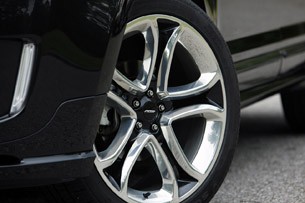
Now for the bad news: if you were hoping to lay your grubby mitts on the new Ecoboost four-cylinder engine Ford plans to offer in the Edge, you're going to have to wait until late next year. In the meantime, the Blue Oval has upped the available engines by one. In Sport trim, the crossover now packs a 3.7-liter V6 with 305 horsepower and 280 pound-feet of torque, all while returning 18 mpg city and 25 mpg highway. That extra grunt helps the Sport feel a little lighter on its feet compared to its siblings, but the acceleration is hardly neck-snapping.
The SE, SEL and Limited models all come from the factory with a 3.5-liter V6 with 285 hp and 253 lb-ft of torque for now, though the smaller mill serves up 19 mpg city and a more impressive 27 mpg highway. Power from both engines makes its way to either the front wheels or an all-wheel drive system via a six-speed automatic transmission.
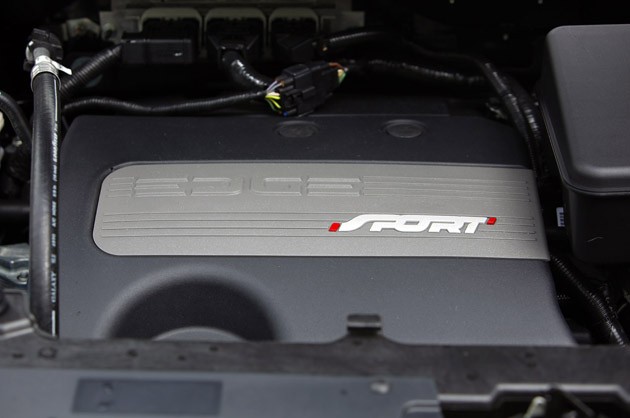
Ford had us out to the hills of Tennessee to put the Edge through its paces on a variety of roads, from full-on interstates to twisty single-lane threads of asphalt, and rarely did it disappoint. Lean on the throttle in the Sport and you're rewarded with acceleration that's quick enough to get you to speed without feeling bored, but slow enough to keep you from getting into too much trouble. Down the undulating apexes of Tennessee's Natchez Trace Parkway, the Sport felt more planted compared to its SEL sibling, but we're not entirely sure the average Edge owner would note any differences in the suspension setup. They would, however, note the firmer, more capable brakes in both vehicles compared to the 2010 model. It's a big – and welcome – difference.
Combined with the significantly quieter cabin, the revisions to the Edge's driving experience makes for a more enjoyable vehicle. What's more, we're guessing when buyers opt for the upcoming Ecoboost four-cylinder, fuel economy will improve in direct proportion to driving enjoyment – a recipe sure to put the hurt on the rest of the high-riding bruisers.
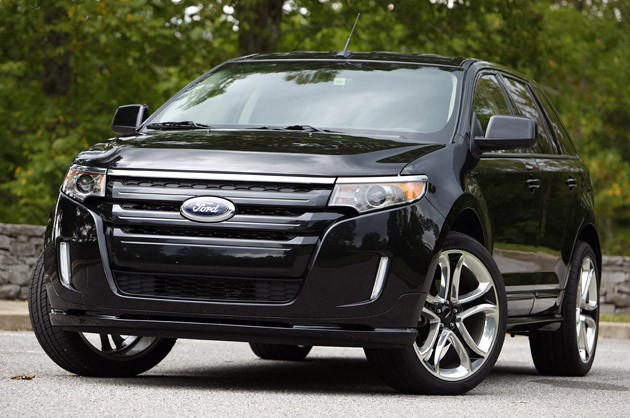
If this whole recipe sounds like the kind of thing you could get excited about, Ford will be happy to put the keys (or key fob, whichever the case may be) in your hands starting at $27,220 for SE trim. Stepping up to all of the fun stuff in Sport trim will hit your bank account for $36,995, though it doesn't take much effort to start optioning well above $40,000.
And here's where we run into the hitch in our giddy-up. That kind of money can buy you a lot of vehicle, even within the Ford stable. The Flex, Explorer and Edge are all within $2,000 of each other and offer up similar functionality for under $30,000. With the Explorer having kicked its body-on-frame habit, the parallels between it and the Edge are almost too numerous to count. The real question is whether the Edge will continue to rely on its unique styling to differentiate itself from the rest of the family or if Ford will choose to make one of its crossover entries a new value story. If it were us at the helm, we'd chop $5k off of the MSRP of the Edge to put some growing room between the three. But as it is, the Edge has the style and substance to keep it on top – as long as you keep the option check boxes at bay.


Our tester came rolling on those fancy, split five-spoke wheels and carried all of the rest of the Sport regalia as well. In its most aggressive trim, the Edge's massive chrome grille of the SE, SEL and Limited models gets swapped for a blacked-out piece that looks menacing no matter the finish. When the Edge wears the Tuxedo Black Metallic hue of our tester, the crossover is downright sinister. That effect is bolstered by the smoked tail lamp lenses and the wheel's matching wheels tuxedo-black accents. We get the feeling that this is the vehicle the FBI would use as standard equipment if it suddenly found a sense of style.
Otherwise, the Edge keeps the same not-quite-round profile we've come to appreciate outside. The story is completely different once you open the driver's door, though. Whereas the 2010 model could boast an interior that was perfectly capable of keeping its head level with the crossover waters, the 2011 version is now the same kind of beautiful found in the 2011 Mustang. The bland, blocky center stack that dominated the old dash has been banished for a new, sweeping design that features a pass-through nestled behind thin audio and climate controls. In Sport trim, those controls were designed by the minds at Sony – the same crew that penned the slick buttons on consumer electronics like the PlayStation3 and any number of massive televisions. Ford calls the control tech "touch capacitive" and there are no buttons to push or levers to slide. Simply run your finger across your choice and the electronics do the rest. It's beyond cool. While lower-rung trims don't carry the fancy Sony switchgear, they do benefit from the same touch capacitive tech. Of course, we prefer the backlit goodness of the Sport's interior, but the center stack on the SEL is just as handsome.




One of the biggest shortcomings of the interior in the 2010 Edge was the crossover's instrument cluster. While the rest of the vehicle carried itself as a futuristic, forward-looking craft, the gauges looked as though they'd been borrowed from the last century. Fortunately, when 1998 called looking for its speedometer, Ford was happy to hand it over. The company swapped in a slick unit with two small LCD screens on either side of a large, zero-down speedometer. Each screen is individually controlled by two five-way switches on the steering wheel. To the left, the driver is supplied with a range of pertinent vehicle information – average fuel economy from the past 30 minutes, over all fuel economy, traction control settings, temperature gauge and tachometer, among others – from easy-to-navigate nested menus. Very handy.
The right screen serves up a condensed version of the same information displayed on the large eight-inch touch screen on the center stack. In a stroke of genius, the screens are color coded – red for the entertainment system, green for navigation, blue for climate control and yellow for the hands-free phone system. The idea here is the less time the driver spends staring down and away from the road, the better. The screen will even show you your turn-by-turn directions, complete with distances and road names.




Ford also decided to debut the company's new MyTouch system on the 2011 Edge. The next evolutionary step in Sync, MyTouch now recognizes over 10,000 different voice commands, allowing you to control nearly everything in the cabin without your hands leaving the steering wheel. At least, that's the theory. During our short time with the system, we had a few issues getting the onboard brain to comprehend our (apparently) muddled voices. It did handle dialing a phone number with nothing more than a spoken command to guide it, which is pretty impressive. When it comes to adjusting the stereo or climate controls, however, we'll probably just stick to fiddling with the trick center stack controls.
More impressive is Ford's move to eschew the traditional DVD or hard drive-based navigation system in favor of a simple SD card set up. For under $800, you can have a complete map-based navigation system with 3D images of important landmarks and a bevy of points of interest. Of course, if you don't feel like shelling out that kind of cash, each Edge comes with Sync Services turn-by-turn navigation without the maps free for the first three years.




It's tempting to think that Ford simply slapped a new grille on the Edge and shoved a boatload of new tech into the cabin, but the company's engineers have taken the time to iron out some of the issues that reared their heads on the outgoing model. For starters, the cabin is significantly quieter, thanks in part to increased baffles mounted in areas previously empty, as well as a thicker firewall to isolate the cabin from engine noise. Under the hood, that sizable piece of plastic obscuring the engine helps to direct noise away from the occupants. Likewise, an acoustic windshield is part of the recipe for all models, and higher trims also get acoustic side glass to keep road noise at bay.
As anyone who has ever driven a 2010 Edge can tell you, the crossover didn't exactly come from the factory with confidence-inspiring brakes. Ford has taken care of that problem by building in a firmer pedal feel with less fade thanks to a new set of larger rear rotors as well as new calipers and pads. With the roads wet during the majority of our drive, we didn't get a chance to really lay on the stoppers, but the pedal was finally devoid of that warm marshmallow feel of last year's model.
With stopping sorted out, Ford turned its attention to working on the suspension to accommodate the larger wheel selections. Completely new springs, shock absorbers and stabilizer bars were installed to cope with the added unsprung weight, and surprisingly enough, the 2011 Edge serves up a ride that isn't rough or jarring, even with the 22-inch wheels found on the Sport.


Now for the bad news: if you were hoping to lay your grubby mitts on the new Ecoboost four-cylinder engine Ford plans to offer in the Edge, you're going to have to wait until late next year. In the meantime, the Blue Oval has upped the available engines by one. In Sport trim, the crossover now packs a 3.7-liter V6 with 305 horsepower and 280 pound-feet of torque, all while returning 18 mpg city and 25 mpg highway. That extra grunt helps the Sport feel a little lighter on its feet compared to its siblings, but the acceleration is hardly neck-snapping.
The SE, SEL and Limited models all come from the factory with a 3.5-liter V6 with 285 hp and 253 lb-ft of torque for now, though the smaller mill serves up 19 mpg city and a more impressive 27 mpg highway. Power from both engines makes its way to either the front wheels or an all-wheel drive system via a six-speed automatic transmission.

Ford had us out to the hills of Tennessee to put the Edge through its paces on a variety of roads, from full-on interstates to twisty single-lane threads of asphalt, and rarely did it disappoint. Lean on the throttle in the Sport and you're rewarded with acceleration that's quick enough to get you to speed without feeling bored, but slow enough to keep you from getting into too much trouble. Down the undulating apexes of Tennessee's Natchez Trace Parkway, the Sport felt more planted compared to its SEL sibling, but we're not entirely sure the average Edge owner would note any differences in the suspension setup. They would, however, note the firmer, more capable brakes in both vehicles compared to the 2010 model. It's a big – and welcome – difference.
Combined with the significantly quieter cabin, the revisions to the Edge's driving experience makes for a more enjoyable vehicle. What's more, we're guessing when buyers opt for the upcoming Ecoboost four-cylinder, fuel economy will improve in direct proportion to driving enjoyment – a recipe sure to put the hurt on the rest of the high-riding bruisers.

If this whole recipe sounds like the kind of thing you could get excited about, Ford will be happy to put the keys (or key fob, whichever the case may be) in your hands starting at $27,220 for SE trim. Stepping up to all of the fun stuff in Sport trim will hit your bank account for $36,995, though it doesn't take much effort to start optioning well above $40,000.
And here's where we run into the hitch in our giddy-up. That kind of money can buy you a lot of vehicle, even within the Ford stable. The Flex, Explorer and Edge are all within $2,000 of each other and offer up similar functionality for under $30,000. With the Explorer having kicked its body-on-frame habit, the parallels between it and the Edge are almost too numerous to count. The real question is whether the Edge will continue to rely on its unique styling to differentiate itself from the rest of the family or if Ford will choose to make one of its crossover entries a new value story. If it were us at the helm, we'd chop $5k off of the MSRP of the Edge to put some growing room between the three. But as it is, the Edge has the style and substance to keep it on top – as long as you keep the option check boxes at bay.
Photos Copyright ©2010 Zach Bowman / AOL

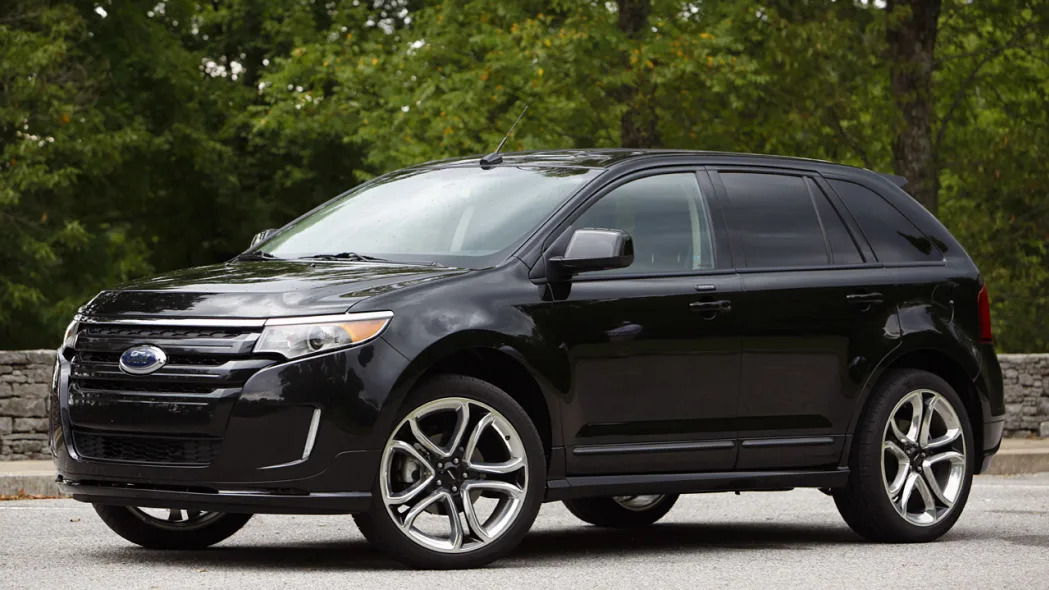

Sign in to post
Please sign in to leave a comment.
Continue